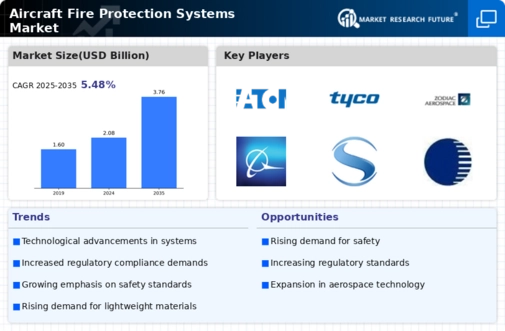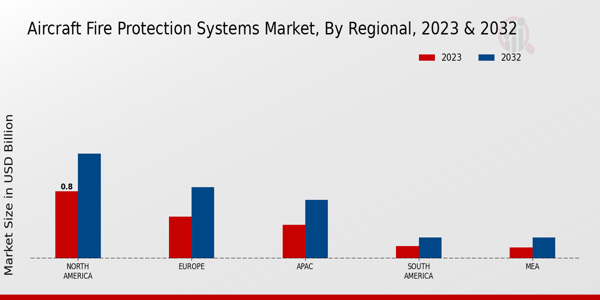Market Trends
Introduction
In 2023, the aircraft fire-prevention system market is experiencing significant transformation. This is mainly due to the confluence of macroeconomic factors such as technological advancements, regulatory pressures and changing consumer preferences. Materials and sensors are being developed to enhance the performance and reliability of fire-prevention systems. At the same time, regulatory requirements are forcing manufacturers to adopt more robust solutions. In addition, the growing focus on the environment and on operational efficiency is putting pressure on the industry to adopt advanced fire-prevention systems that not only meet regulatory standards but also help meet environmental goals. These trends are strategically important for all stakeholders as they navigate the highly competitive market, ensure regulatory compliance and enhance safety and meet the changing demands of the aviation industry.
Top Trends
-
Increased Regulatory Compliance
Governments are adopting stricter regulations on the safety of air travel, resulting in the development of better fire prevention. For example, the FAA has mandated that the fire detection system on commercial aircraft be made more effective. This is pushing the manufacturers to improve the systems and increase the cost of the operation, but it also increases the safety of the aircraft. The companies that can adapt to the new regulations quickly will have a competitive advantage. These developments could include more advanced materials and newer technology. -
Advancements in Fire Suppression Technologies
A new form of fire-extinguishing equipment is becoming common, such as the use of special foams. The big industry is investing in research to develop more effective and environmentally friendly fire-extinguishing systems. The use of biodegradable foams, for example, is gaining ground. This trend not only enhances the safety of people, but it also meets the requirements of the concept of sustainable development. In the future, this trend may spread to other aircraft types. -
Integration of IoT in Fire Protection Systems
On the other hand, the integration of Internet of Things (IoT) technology in fire prevention systems is growing, enabling real-time monitoring and data analysis. IoT is being used to improve preventive maintenance and to improve the speed of emergency response. This is expected to reduce downtime and operating costs significantly. The evolution of IoT technology may lead to more complex systems that automatically detect and respond to fire hazards. -
Focus on Lightweight Materials
A tendency to reduce weight in aeroplane construction has led to a similar tendency in fire-prevention devices. In other words, manufacturers are seeking materials which will be light as well as resistant to fire. For example, the properties of composite materials are being tested. This tendency is important in the light of the saving of fuel and the consequent improvement in the performance of the aeroplane. Moreover, future developments may lead to the invention of entirely new materials which will satisfy both the requirements of weight and safety. -
Enhanced Training and Simulation Programs
There is a growing emphasis on the importance of fire-fighting training and simulation in the aviation industry. The manufacturers and the operators of the aircraft are investing in the most advanced simulation technology in order to train their crews to deal with fire emergencies. This trend is supported by the results of studies which have shown that well-trained crews can significantly reduce the severity of an accident. The evolution of the training programs is likely to lead to a more realistic and more immersive training environment, which will improve the safety outcomes. -
Collaboration Between Manufacturers and Airlines
The co-operation between aircraft manufacturers and air carriers is increasing in the field of fire protection. The aim of these co-operations is to develop and to supply special solutions for the individual operational requirements of the aircraft. This trend is promoting innovation and making the systems effective and practical. Co-operation in the future may lead to standard solutions that can be used in various fleets. -
Increased Investment in R&D
There has been a noticeable increase in the level of investment in fire-protection research and development. Companies are investing more and more in new products and in improving existing systems, prompted by the need to remain competitive and by the regulatory requirements. This is expected to result in major advances in the methods of fire detection and fire suppression. We may see the introduction of the next generation of systems, which will set new standards. -
Sustainability in Fire Protection Solutions
In the development of fire protection systems, the question of the environment is becoming a major issue. Materials and processes are being developed that are as environmentally friendly as possible. This development is a result of both legal requirements and the desire of the public for greener solutions. As the importance of sustainability increases, we may see a shift towards a more thorough life-cycle assessment of fire protection products. -
Adoption of Advanced Detection Systems
In this connection, the spread of the use of the latest fire detection systems, such as those based on machine learning, is advancing. These systems are able to learn from data patterns and so are better able to forecast potential fires. This trend is improving safety and reducing the number of false alarms that can disrupt operations. And further developments will likely result in fully automatic fire detection systems that will be integrated into the other systems of the aircraft. -
Global Supply Chain Resilience
The recent disruptions to the supply chains have led to a review of the sourcing of fire-fighting components. The risk of a single source of supply has been recognized. To reduce this risk, the industry is diversifying its suppliers. This will increase costs but also improve availability. Local manufacture and sourcing may be future developments to increase resilience.
Conclusion: Navigating Competitive Waters in 2023
Aircraft Fire Protection in 2023 will be characterized by intense competition and considerable fragmentation, with both established and new entrants fighting for market share. Across all regions, safety compliance is becoming a greater priority, driving innovation and adaptation. To differentiate themselves, the established players are relying on their reputations and expertise, while the new entrants are focusing on cutting-edge technology such as artificial intelligence and automation. Strategic considerations for suppliers include the need to enhance capabilities in the areas of agility and resilience. These factors will become increasingly important for market leadership. As the market evolves, decision-makers must ensure that their strategic priorities and alliances align with these critical capabilities.











Leave a Comment